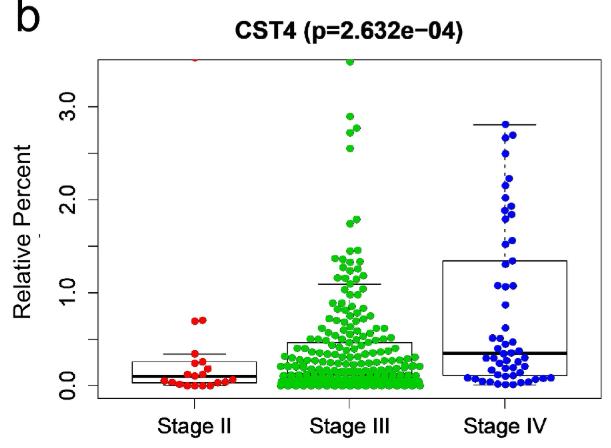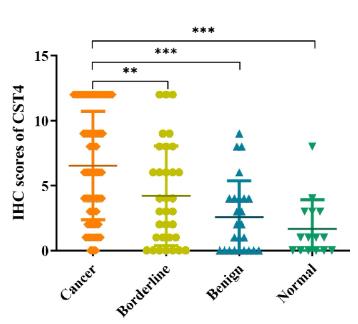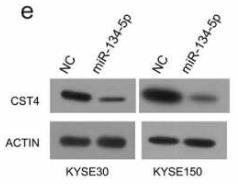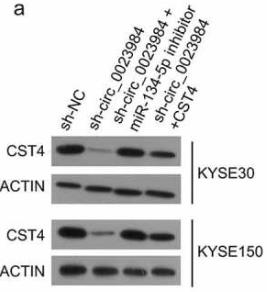Recombinant Human CST4 protein(Met1-Ala141), His-tagged
| Cat.No. : | CST4-3212H |
| Product Overview : | Recombinant Human CST4 (NP_001890.1) (Met 1-Ala 141) was expressed in HEK293, fused with a polyhistidine tag at the C-terminus. |
| Availability | April 04, 2025 |
| Unit | |
| Price | |
| Qty |
- Specification
- Gene Information
- Related Products
- Case Study
- Application
- Download
| Species : | Human |
| Source : | HEK293 |
| Tag : | His |
| Protein Length : | Met1-Ala141 |
| Form : | Lyophilized from sterile PBS, pH 7.4. Normally 5 % - 8 % trehalose, mannitol and 0.01% Tween80 are added as protectants before lyophilization. |
| Molecular Mass : | The secreted recombinant human CST4 consists of 132 amino acids and migrates as an approximately 16 kDa band in SDS-PAGE under reducing conditions as predicted. |
| Endotoxin : | < 1.0 EU per μg of the protein as determined by the LAL method. |
| Purity : | > 98 % as determined by SDS-PAGE |
| Storage : | Samples are stable for up to twelve months from date of receipt at -20°C to -80°C. Store it under sterile conditions at -20°C to -80°C. It is recommended that the protein be aliquoted for optimal storage. Avoid repeated freeze-thaw cycles. |
| Reconstitution : | It is recommended that sterile water be added to the vial to prepare a stock solution of 0.2 ug/ul. Centrifuge the vial at 4°C before opening to recover the entire contents. |
| Gene Name | CST4 cystatin S [ Homo sapiens ] |
| Official Symbol | CST4 |
| Synonyms | CST4; cystatin S; cystatin-S; cystatin 4; cystatin-4; cystatin-SA-III; salivary acidic protein 1; MGC71923; |
| Gene ID | 1472 |
| mRNA Refseq | NM_001899 |
| Protein Refseq | NP_001890 |
| MIM | 123857 |
| UniProt ID | P01036 |
| ◆ Recombinant Proteins | ||
| CST4-5793H | Recombinant Human CST4 Protein, Myc/DDK-tagged, C13 and N15-labeled | +Inquiry |
| CST4-2027H | Recombinant Human CST4 Protein, GST-tagged | +Inquiry |
| CST4-1853H | Recombinant Human CST4 Protein (Ser21-Ala141), N-His tagged | +Inquiry |
| CST4-1851H | Recombinant Human CST4 Protein (Ser21-Ala141), C-His tagged | +Inquiry |
| CST4-3353H | Recombinant Human CST4 Protein, MYC/DDK-tagged | +Inquiry |
| ◆ Cell & Tissue Lysates | ||
| CST4-2241HCL | Recombinant Human CST4 cell lysate | +Inquiry |
Case 1: Wang S, et al. Life Sci. 2021
Ovarian cancer, a leading cause of death among gynecological tumors, faces hurdles in pinpointing effective immune targets and markers. By analyzing 379 OC samples with CIBERSORT, researchers found that three immune cell types were linked to worse outcomes, and 17 related genes stood out. Among them, CST4 emerged as a key immune-related prognostic gene, showing high expression in patients and correlating with poorer prognoses. This highlights how immune cell infiltration impacts OC survival and positions CST4 as a potential therapeutic target, offering new insights into the cancer's immune environment and aiding in immunotherapy development.

Fig1. The relationship between CST4 and FIGO stage.

Fig2. Immunohistochemistry staining scores of CST4 in ovarian tissues samples.
Case 2: Yang G, et al. Bioengineered. 2022
CircRNAs can influence cancer by interacting with microRNAs. In esophageal squamous cell carcinoma (ESCC), high levels of circ_0023984 were noted, linked to poor outcomes. This study found that silencing circ_0023984 in ESCC cells reduced their growth, invasion, and migration. It inhibits miR-134-5p, boosting CST4, a protein promoting tumors. In mice, circ_0023984 spurred tumor growth via CST4, suggesting it's a potential target for future treatments.

Fig1. WB analysis of CST4 protein level after miR-134-5p overexpressing in KYSE150 and KYSE30 cells.

Fig2. WB analysis of CST4 protein levels in KYSE150 and KYSE30 cells with indicated treatments.
Not For Human Consumption!
Inquiry
- Reviews
- Q&As
Ask a Question for All CST4 Products
Required fields are marked with *
My Review for All CST4 Products
Required fields are marked with *
Inquiry Basket


